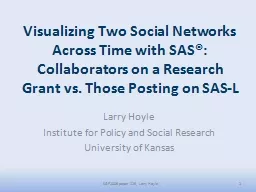PPT-Visualizing Two Social Networks Across Time with SAS®:
Author : phoebe-click | Published Date : 2019-06-28
Collaborators on a Research Grant vs Those Posting on SASL Larry Hoyle Institute for Policy and Social Research University of Kansas 1 SGF2009 paper 229 Larry Hoyle
Presentation Embed Code
Download Presentation
Download Presentation The PPT/PDF document "Visualizing Two Social Networks Across T..." is the property of its rightful owner. Permission is granted to download and print the materials on this website for personal, non-commercial use only, and to display it on your personal computer provided you do not modify the materials and that you retain all copyright notices contained in the materials. By downloading content from our website, you accept the terms of this agreement.
Visualizing Two Social Networks Across Time with SAS®:: Transcript
Download Rules Of Document
"Visualizing Two Social Networks Across Time with SAS®:"The content belongs to its owner. You may download and print it for personal use, without modification, and keep all copyright notices. By downloading, you agree to these terms.
Related Documents














